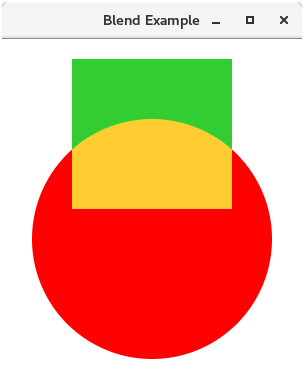📌 相关文章
- JavaFX-效果
- JavaFX-效果(1)
- JavaFX 阴影效果
- JavaFX 阴影效果(1)
- 混合 (1)
- 混合与短吻
- 混合云(1)
- 混合云
- 混合与短吻(1)
- JavaFX 镜像效果(1)
- JavaFX 镜像效果
- 水效果 (1)
- JavaFX |弧与示例
- JavaFX |弧与示例(1)
- 混合 - 任何代码示例
- JavaFX Bloom效果(1)
- JavaFX Bloom效果
- JavaFX BoxBlur效果
- JavaFX BoxBlur效果(1)
- JavaFX 运动模糊效果
- JavaFX 运动模糊效果(1)
- JavaFX DropShadow效果(1)
- JavaFX DropShadow效果
- C#|混合字典类(1)
- C#|混合字典类
- JavaFX ColorAdjust效果(1)
- JavaFX ColorAdjust效果
- JavaFX SepiaTone效果(1)
- JavaFX InnerShadow效果
📜 JavaFX 混合效果
📅 最后修改于: 2020-10-14 01:29:54 🧑 作者: Mango
JavaFX混合效果
通常,混合效果产生的输出是由于两个或多个不同输入节点的混合而产生的。它需要两个或更多节点的像素,根据所应用的混合模式对其进行混合,并在同一位置生成输出节点。
如果两个图像相互重叠,则将混合模式应用于两个图像的重叠区域。
物产
该类包含四个属性,这些属性及其下表中的setter方法进行了描述。
| Property | Description | Setter Methods |
|---|---|---|
| bottomInput | The bottom input for the blend operation. This is a object type property. | setBottomInput(Effect value) |
| mode | The mode according to which, the inputs are blend together. | setMode(BlendMode value) |
| opacity | This is the opacity value of double type. | setOpacity(double value) |
| topInput | The top input for the blend operation. | setTopInput(Effect Value) |
建设者
此类中有三个构造函数。
- Blend():使用默认值实例化Blend类。
- Blend(BlendMode模式):以指定模式实例化Blend类
- Blend(BlendMode模式,BottomInput效果,TopInput效果):使用指定的混合模式,Bottom Input效果和Top Input效果实例化Blend类。
例:
package application;
import javafx.application.Application;
import javafx.scene.Group;
import javafx.scene.Scene;
import javafx.stage.Stage;
import javafx.scene.shape.Circle;
import javafx.scene.effect.Blend;
import javafx.scene.effect.BlendMode;
import javafx.scene.effect.ColorInput;
import javafx.scene.paint.Color;
public class BlendExample extends Application {
@Override
public void start(Stage primaryStage) {
Circle circle = new Circle(150,200,120);
circle.setFill(Color.RED);
Blend blend = new Blend();
ColorInput color = new ColorInput(70, 20, 160, 150, Color.LIMEGREEN);
blend.setTopInput(color);
blend.setMode(BlendMode.ADD);
circle.setEffect(blend);
Group root = new Group(circle);
Scene scene = new Scene(root, 300,350);
primaryStage.setTitle("Blend Example");
primaryStage.setScene(scene);
primaryStage.show();
}
publicstaticvoid main(String args[]){
launch(args);
}
}

混合模式
JavaFX提供了各种混合模式,可以使用它们来修改混合效果。
| Blend Mode | Description | Output |
|---|---|---|
| Add | The color components of the top input are added to that from the bottom input. |  |
| Blue | Only Blue components of the bottom input gets replaced by the blue component of top input. |  |
| COLOR_BURN | The bottom input color gets inverted and divided by the top input color components. The result is again inverted to get the output color. |  |
| COLOR_DODGE | The top color components gets inverted and divide the bottom color components to produce the output color. |  |
| DARKEN | The color which is darker of the two input component colors is selected to produce the resulting color. |  |
| DIFFERENCE | The darker of the two input color is subtracted from the lighter color to produce the resulting color. |  |
| EXCLUSION | The two input color components are multiplied and doubled and then subtracted from the sum of bottom color components to produce the desired color. |  |
| GREEN | The green component from the bottom input is replaced by the green input of top component. |  |
| HARD_LIGHT | The input color components are either multiplied or screened depending upon the bottom color. |  |
| LIGHTEN | The lighter color of the two color components is produced as output. |  |
| MULTIPLY | Both the color components get multiplied to produce the output color. |  |
| OVERLAY | The input color components gets either screened or multiplied depending upon the bottom color. |  |
| RED | The red components of bottom input gets replaced with the red components of top input. |  |
| SCREEN | Both color components are inverted, multiplied and again inverted to produce the desired result. |  |
| SOFT_LIGHT | The input color components become lighten or darken. |  |
| SRC_ATOP | The part of the top input that is lying over the bottom input gets blended. |  |
| SRC_OVER | Top input gets blended over bottom input. |  |